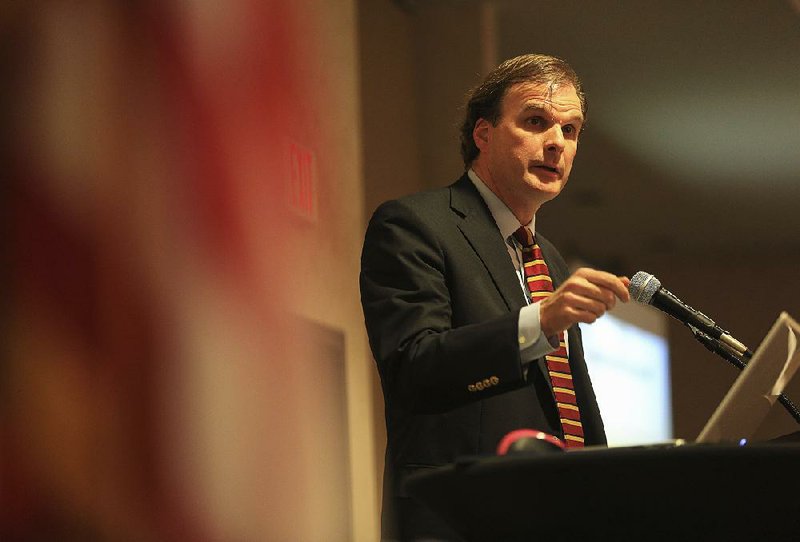Forest-restoration projects in Arkansas that are designed to prevent wildfires and to improve wildlife habitat and soil and water health are getting $3.7 million in 2016 from the U.S. Forest Service and the U.S. Department of Agriculture's Natural Resources Conservation Service.
Robert Bonnie, the USDA's undersecretary of natural resources and environment, was on hand Tuesday at the Arkansas Association of Conservation Districts' annual meeting at the Wyndham hotel in North Little Rock, where he announced the funds. A new forest-restoration project in the Ozark-St. Francis and Ouachita national forests is included in the funding.
On Tuesday, the department announced $40 million for 39 projects nationwide, including $11 million for 11 new projects. All of the projects are designed to restore forests and reduce wildfire threats through partnerships between public agencies and private landowners.
"That's how conservation should work," Bonnie said, referring to the partnerships. The advantage of those partnerships is that many problems in forests are not limited to one owner's land, officials noted.
While all projects, including new ones, will be funded for at least three years, Bonnie said, this is the last year of the federal program, called the Joint Chiefs' Landscape Restoration Project. He said he'd like to see it continue under a new presidential administration and that he believes the program has proved its worth.
The increase in project funding for 2016 coincides with an increase in wildfires nationwide and complaints from lawmakers over "fire borrowing," which refers to the practice of fighting fires using funds withheld from programs designed to survey forests or prevent fires elsewhere.
Bonnie said that last year wildfires burned more than 10 million acres, the largest amount in more than 50 years.
A U.S. Forest Service report released in the summer detailed an increase in costs of wildfires nationally, from 16 percent of the agency's budget in 1995 to 55 percent of the agency's budget in 2015. The report also cites climate change as a factor in wildfires, noting fire seasons are lasting 78 days longer on average than they did in the 1970s.
Officials with the U.S. Forest Service and the National Weather Service in Arkansas said the wildfire problem is mainly out West, where droughts are worse.
Bonnie said Tuesday that places in the Western U.S., where tensions between public agencies and private landowners are high, should look at partnerships in Arkansas and other Southern states for guidance in addressing wildfire management. Some already are, he said, noting the funding of the Trinity County Community Protection Project in Northern California, which endured wildfires across tens of thousands of acres last summer.
Bonnie called Arkansas a "golden child" for these federal funds and said he chose to make the Natural Resources Conservation Service's announcement in the state because the state is a good model for partnerships in forest restoration.
The projects receiving funding are locally led and were applied for at a local level. The funding comes from the Joint Chiefs' Landscape Restoration Partnership, which started in 2014 and includes the U.S. Forest Service and the Natural Resources Conservation Service.
The Forest Service will work on federal land, and the Natural Resources Conservation Service will work with private landowners who volunteer their land for restoration efforts, which would include prescribed burns, tree planting and other measures.
In Arkansas, the restoration efforts will go beyond preventing wildfires and will improve tree health and reduce sediment runoff into water bodies, including those that are used as drinking water sources, officials said.
Receiving a little over $3 million in 2016 is a project started in 2014 in Arkansas, called Western Arkansas Woodland Restoration. About $1 million will come from the Forest Service and about $2 million from the Natural Resources Conservation Service. The project has a few dozen partners.
Most of that land is privately owned, and less than 10 percent of landowners have forest-management plans, according to a Natural Resources Conservation Service report on the project. The project seeks to restore 10,000 acres in the Ouachita National Forest.
In areas that have had prescribed burns, a wildfire is less likely to happen when humidity is low and winds are high, state Forester Joe Fox said. Restoration also has helped the bobwhite quail, he said.
"There's many, many benefits," Fox said.
Part of the $3.7 million announced Tuesday will help expand the project into Oklahoma, where partners will include the state forest service and at least one American Indian tribe.
The forest-restoration project in the Ozark-St. Francis and Ouachita national forests also will take place during the next three years in Arkansas and Oklahoma.
The project, simply called Woodland Restoration 2016-2018, also will help reduce feral hog populations near water bodies, which can pose problems for water quality, said Shawn Cochran, ecosystems staff officer for the Ozark-St. Francis National Forest.
The project received $668,750 for its first year -- $318,750 from the U.S. Forest Service and $350,000 from the Natural Resources Conservation Service. That's more than $2 million less than the state's first project received in its first year, but Bonnie said the first-year funding reflects uncertainty over private landowner participation early on.
Metro on 02/17/2016
